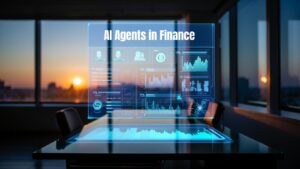In high-value transactions, missed details can lead to substantial financial and regulatory exposure. When due diligence is rushed, the likelihood of such risks increases.
Take UBS’s emergency acquisition of Credit Suisse. With less than four days to assess the deal, UBS had limited time to find hidden liabilities. As a result, it had to set aside around $4 billion to cover legal and regulatory fallout. Traditional due diligence could not meet the demands of the situation.
This highlights a clear need for more efficient, insight-driven approaches. AI meets this demand by processing large volumes of data, detecting patterns, and modeling outcomes. It enables faster, more thorough analysis—capabilities that RTS Labs provides to its clients.
In this article, you’ll see how AI is reshaping due diligence across various industries and how RTS Labs can help you act with more clarity and confidence.
What Is AI-Powered Due Diligence?
AI in due diligence refers to the use of artificial intelligence to make the review and assessment process faster, more consistent, and less resource-intensive. It helps teams assess risk, verify information, and extract insights from large datasets while reducing manual effort.
Technologies like automation, NLP, and machine learning work together—each supporting a specific stage of the workflow. Automation, for example, manages repetitive tasks such as sorting documents, extracting data, and cross-checking information. NLP analyzes contracts, filings, and emails to identify key terms and risk factors. Machine learning detects patterns or irregularities in financial and operational data to support deeper analysis.
What’s the Difference Between AI Due Diligence and Traditional Due Diligence?
To better understand the value AI provides, let’s compare how AI-powered due diligence differs from traditional methods across key dimensions:
| Category | Traditional Due Diligence | AI-Based Due Diligence |
|---|---|---|
| Speed | Slow and time-consuming (weeks to months) | Rapid analysis (minutes to hours) |
| Data volume handling | Limited to what teams can manually review | Scales easily to millions of documents and data points |
| Accuracy | Prone to errors caused by fatigue or manual oversight | High accuracy with reduced manual errors |
| Risk detection | Reactive, based on predefined checklists | Proactive, flags hidden and emerging risks through ML |
| Unstructured data handling | Requires manual extraction and interpretation | NLP automates parsing of contracts, emails, reports, etc. |
| Cost | High labor costs due to manual effort | Lower long-term costs through automation |
| Consistency | Varies by team, time, and workload | Consistent analysis across all datasets and documents |
| Reporting | Static, manually written reports | Dynamic, automated reports and dashboards |
| Reusability of models | Limited—case-specific and not scalable | AI models improve over time and can be reused across cases |
How AI Due Diligence Works
AI in due diligence works by using AI to analyze vast volumes of unstructured data, reading every file to find what manual reviews would miss. It then flags critical risks, like hidden liabilities and compliance gaps, and delivers a clear risk summary so your team can act decisively.
Here is how that process works in practice:
Step 1: Data Aggregation and Structuring
First, the AI builds a complete intelligence profile by aggregating data from all relevant sources like internal systems, public records, news, and social media.
The AI uses technologies like OCR and NLP to clean, label, and structure disorganized content such as contracts, compliance reports, and audit summaries. From this structured foundation, critical risks, contract inconsistencies, and compliance gaps can be surfaced and analyzed promptly.
RTS Labs supports this through Data Engineering services. These include building data lakes and extract-transform-load (ETL) pipelines that prepare information for AI analysis.
For example: A logistics company managing several regional suppliers can use automated pipelines to bring together shipment logs, customs records, and vendor histories. This helps compliance teams find accurate data quickly.Instead of going through files manually, they can review supplier risks from one structured system.
Suggested read : The Role of Data Engineering Consulting in Building Scalable Architectures
Step 2 – Intelligent Data Analysis and Extraction
Once the data is structured, AI begins to analyze it for key insights. Natural Language Processing (NLP) scans legal, financial, and operational documents to extract important clauses, terms, and figures.
Machine learning models identify patterns or anomalies. This includes sudden revenue changes, irregular payments, or missing disclosures. Simultaneously, sentiment analysis gauges public perception from news and social media. It flags reputational risks that can directly impact the target’s brand value and future growth.
RTS Labs supports this through AI-powered applications that apply machine learning, NLP, and predictive analytics to surface critical findings and flag potential risks early.
For example: A finance firm evaluating a new investment can use this setup to review earnings reports, regulatory filings, and public coverage.
The system might flag a revenue spike without explanation, missing audit notes, or negative sentiment linked to leadership. This allows analysts to prioritize these flagged anomalies for deeper investigation.
Step 3: Risk Identification and Prioritization
Detecting issues is just the first step; evaluating their impact is what drives decisions. To enable this, the AI automatically flags high-risk patterns like data inconsistencies, compliance gaps, and delayed filings.
The system then ranks these findings by relevance and potential impact, directing your team’s focus to the most critical threats and opportunities.
RTS Labs supports this through Data Science consulting. We build predictive models and tailored analytics that help businesses identify and prioritize risk patterns based on their business context.
For example: A construction firm evaluating new project partners can use an AI-powered model to review past safety incidents, delivery delays, and cost overruns.
This analysis can instantly highlight recurring patterns, allowing the firm to accurately price project risk and select more reliable partners.
Step 4 – Reporting and Visualization
After extracting high-risk indicators, the system compiles them into automated reports and visual dashboards. Reports summarize key findings, while dashboards present data visually to help leaders quickly assess risk and decide next steps.
RTS Labs supports this with tailored BI solutions. We build real-time dashboards, data marts, and visual reports that make insights easier to use in everyday decision-making.
For example: A supply chain company can use a custom dashboard that continuously ingests data from shipping logs, customs databases, and supplier audits across ten countries to monitor risk.
If new data reveals a vendor in Southeast Asia has repeated compliance issues, a predefined rule is triggered, instantly highlighting that supplier on the dashboard. This helps procurement leads act quickly—rerouting orders or re-evaluating contracts before disruptions escalate.
Now that we’ve seen how AI fits into the due diligence process, let’s look at the advantages it provides.
Key Advantages of AI in Due Diligence
AI redefines how due diligence works at every level. From quicker reviews to smarter predictions, here are the most practical benefits it brings to the table:
Faster deal evaluations:
AI speeds up due diligence by automating the slow, manual task of reviewing documents and extracting important data. This allows teams to complete due diligence more efficiently, often shortening timelines by 2–3 weeks, depending on complexity.
For example, a real estate company faced delays from manually reviewing complex lease agreements. This held up key operational decisions and made compliance tracking difficult. They partnered with RTS Labs to implement an AI solution, which led to clear results:
- Lease analysis became 70% faster through automated data extraction.
- Error rates dropped by 40% using AI-powered compliance checks.
- Team productivity increased by 30%, allowing staff to focus on strategic tasks.
This is part of a broader shift in how organizations approach due diligence. According to Thomson Reuters, AI can reduce due diligence document review time by up to 70% on average. It also helps surface critical legal provisions across thousands of documents in just minutes.
Smarter pattern recognition:
McKinsey reports that AI-driven pattern recognition can reduce credit losses by 20 to 40%. This impact comes from AI’s ability to detect subtle, high-risk anomalies that manual reviews often miss.
AI reviews thousands of documents and data points to learn standard patterns, such as typical contract terms or normal financial behavior. Once it establishes that baseline, it flags anything that falls outside the norm. This could be an unusual payment, a non-standard clause, or a data inconsistency.
These red flags may seem minor at first but can lead to serious financial consequences if overlooked. By identifying them early, AI gives teams the clarity to act before risks escalate.
Streamlined document handling:
When Merck partnered with McKinsey, it reduced report preparation time by over 50%. This outcome was driven by AI’s ability to structure and extract data quickly and at scale.
Building on this capability, AI can index large volumes of documents, tag critical terms, and highlight key sections. This helps in eliminating much of the manual effort that slows due diligence and improves consistency across the process. In fact, according to PwC, businesses can reduce manual data extraction time by 30 to 40%.
RTS Labs brings these efficiencies within reach for mid-market and enterprise clients by delivering custom AI pipelines—often deployed in under 90 days.
Increased accuracy:
When teams are required to review thousands of documents manually, maintaining consistency becomes difficult. AI addresses this challenge by automating the organization and processing of information as soon as documents are uploaded.
This means that AI’s performance remains stable regardless of scale or repetition.
Better risk detection:
By learning from large volumes of data, it spots patterns that may signal future risks or opportunities. It catches early signs that people often overlook, helping teams stay ahead of problems before they escalate into costly setbacks.
The same approach can also predict customer churn with over 85% accuracy by spotting behavioral patterns. That means teams can act early, before a deal falls apart This allows teams to intervene early, maintain continuity, and retain critical business partners.
How AI Is Used in Due Diligence Across Key Industries
AI-powered due diligence isn’t limited to one field. Its ability to extract insights, assess risk, and monitor performance makes it valuable across sectors that rely on timely, accurate decision-making. Here’s how it works in practice:
1. Supply Chain, Logistics and Transportation
AI-powered due diligence helps logistics and supply chain teams spot risks, improve performance, and minimize disruptions. It works in four main ways:
- Supplier and partner checks: AI reviews past delivery performance, compliance violations, and legal issues to flag unreliable vendors.
- Operational performance: As a part of ongoing vendor evaluation, AI examines delivery times, maintenance logs, and fuel use to uncover bottlenecks.
- Contract scanning: AI parses large agreements quickly and flag potentially risky clauses or missing terms.
- Disruption prediction: By combining GPS data, customs updates, and labor reports, AI can warn of delays, strikes, or shutdowns before they happen.
RTS Labs brings these capabilities to life with services like:
- Integration with third-party systems and data sources
- Custom modifications or full implementations of Transportation Management Systems (TMS) and Warehouse Management Systems (WMS)
- Development of data-driven dashboards and business intelligence tools
- Rapid prototyping and proof-of-concepts for evolving processes
- Strategic roadmaps to turn logistics data into actionable insights
Each service applies data science and operational technology to improve visibility, decision-making, and efficiency across the supply chain.
Suggested read: Generative AI for Next-Gen Supply Chain Solutions
2. Finance & Fintech
Finance teams must move quickly while meeting strict regulatory standards. AI accelerates document analysis and supports compliance efforts, freeing teams to focus on high-impact decisions. Plus, it helps teams stay ahead by:
- Reviewing financial statements: AI scans balance sheets, income statements, and tax returns to uncover errors and spot emerging trends in revenue, expenses, or liquidity in minutes rather than days.
- Fraud detection and compliance issues: It flags unusual transactions or patterns such as transaction outliers, duplicate invoicing, or misreported revenue—indicators that may point to fraud or regulatory breaches.
- Assessing credit risk: It combines standard metrics with alternative signals, such as payment histories and spending behavior, to evaluate borrower risk profiles with greater precision.
- Forecasting models: Predictive analytics help forecast revenue and cash flow, giving teams a forward-looking view of deal value.
These forecasting strengths prove crucial in due diligence. For example, RTS Labs worked with an asset management firm that routinely missed shifts in market trends during due diligence cycles.
RTS Labs built a dynamic model that combined client segments, live economic data, and “what-if” scenarios. Then we embedded this system into the firm’s ERP system so every due diligence report came with up-to-the-minute revenue forecasts.
As a result, the firm saw:
- Forecast accuracy jumped by 40% Resource optimization increased by 35 percent
- Decision-making in volatile markets became 25% faster
Suggested read: Top 7 AI Use cases in Finance
3. Real Estate & Construction
Construction teams need accurate data to keep projects on track. AI helps by:
- Verifying property and material records: Matching ownership, permits, and supplier details with government registries and regulatory filings.
- Reviewing regulations and approvals: Checking local codes, zoning laws, and permits automatically.
- Valuing projects and assets: Using market trends and site data to generate realistic valuations based on comparable assets and location data.
- Tracking progress and supplier risk: Scanning supplier records, drone images, and site updates to flag delays or safety concerns early.
These checks become more useful when solving real operational challenges. One fiberglass manufacturer, for example, struggled to manage its raw material supply chain.
The company experienced costly delays and storage overruns due to inaccurate raw material forecasting. Long lead times from overseas suppliers made the problem worse, raising red flags during due diligence.
RTS Labs built a predictive forecasting model that consolidated vendor lead times, demand patterns, and inventory data from multiple sources and linked it to their planning tools. As a result:
- Overstocking dropped by 25 percent, reducing storage costs and improving cash flow.
- Forecast accuracy improved by 30 percent, supporting more efficient production scheduling.
- Supply delays fell by 20 percent, enabling more consistent order fulfillment.t
Challenges of Using AI in Due Diligence
Despite its potential, using AI in due diligence comes with challenges that organizations must address. Here are five key barriers to its effective use:
Dealing with Unstructured Data:
McKinsey estimates that more than 80% of enterprise data is unstructured.
In many companies, information is often scattered across PDFs, spreadsheets, emails, and scanned documents. This makes it difficult for AI systems to extract reliable insights at scale
When that data is inconsistent or incomplete, the analysis can lead to missed risks or false confidence.
Pro tip💡: At RTS Labs, we help you address these challenges by building systems that integrate information from multiple formats and sources. Using NLP, our solutions scan documents, extract relevant details, and structure the data so your machine learning models can process it effectively.
Our data pipelines ensure that all inputs are thoroughly cleaned and prepared, providing consistent and reliable data for analysis.
Difficulty Understanding How AI Makes Decisions:
Many AI models, especially the more complex ones, don’t offer much visibility into how they reach conclusions. This lack of clarity can be a challenge when teams need to justify or validate the outcomes.
It creates friction for legal, compliance, and finance teams, who must understand the rationale behind every insight—especially when the stakes are high.
Pro tip💡: Solving this requires AI systems designed with transparency from the outset—not just for performance, but also for explainability. This allows your team to understand and trace how decisions are made by the model.
RTS Labs supports this with governance frameworks, regular bias checks, and monitoring tools. These give you clear visibility and control at every stage of the AI lifecycle.
Lack of Trust from Legal and Finance Teams
Legal and finance teams are trained to look closely at contracts and financial reports. Many are cautious about using AI, especially if they feel it could miss important clauses or numbers. As a result, teams often review AI findings manually, which reduces the time-saving benefits.
Pro tip 💡: With a commitment to traceability, bias detection, and human oversight from the start, RTS Labs designs AI systems that build trust and support responsible adoption.
Through explainable model architectures and integrated governance frameworks, our solutions help legal and finance teams understand how decisions are made.
Concerns About Regulations and Data Privacy
In highly regulated industries, companies must ensure AI tools follow proper data protection and governance standards. Improper handling of sensitive information can result in significant legal and compliance risks.
A recent PwC study found that 60% of executives consider complex regulations one of the biggest challenges when scaling AI—highlighting the need for careful implementation.
Pro tip💡: One way companies are managing this is by building AI systems with compliance from the start.
RTS Labs through its AI Consulting and Data Engineering services, helps organizations:
1. Define governance policies
2. Set up secure data pipelines
3. Ensure all processes align with regulations like GDPR, HIPAA, and CCPA.
On top of that, we integrate privacy checks, access controls, and automated monitoring into every layer of the system. This helps AI to scale without putting your business at risk.
Not Enough Skilled People to Manage AI
Effective use of AI depends on having the right people in place. Many organizations still lack data scientists, engineers, or analysts who can properly build, maintain, and monitor AI systems. Without this expertise, there’s a higher risk of errors, poor performance, or missed insights.
Making Due Diligence Future-Ready with AI
As AI evolves, it’s becoming more than just a support tool in due diligence. It’s helping teams work faster, see risks earlier, and make sharper decisions. Here are three trends pointing to what’s ahead:
Advanced NLP Will Make Document Review Faster and Smarter
Due to advancement in NLP, AI tools can now review contracts, emails, and reports with much greater accuracy. For example, a recent Deloitte case study looked at M&A deals. It found that using Generative AI for due diligence led to a 75% efficiency saving when compared to a traditional manual review.
This represents a significant improvement in speed. It allows the technology to go beyond simple keyword matching. Now, it can spot specific clauses, identify risks, and flag inconsistencies with the precision of a seasoned professional. This frees up your legal and compliance teams to focus on the more strategic analysis that truly matters.
Predictive Analytics Will Help Businesses Stay Ahead, Not Just React
With better predictive analytics, businesses can spot market shifts early, flag potential risks, and even simulate the outcomes of different decisions. That kind of foresight can lead to faster and more confident decision-making, especially when the stakes are high.
McKinsey reports that industries like telecom, energy, and healthcare have already seen predictive AI automate up to 50 % of workforce-management tasks. This has helped reduce costs by 10 to 15 % while also improving hiring outcomes. As forecasting tools become more accurate and accessible, companies will rely on them not just to respond to change, but to plan ahead.
AI Will Automate Compliance Checks Across Borders
Regulations are constantly evolving and lack a single, standardized format. For global companies, staying compliant means keeping track of rules across different countries, industries, and languages. This creates a significant manual workload.
AI is starting to alleviate that load. It can scan new regulations in real time, compare them against internal policies, and flag any discrepancies. This cuts down review time, lowers the risk of errors, and helps teams act faster when the rules shift.
Globally, 49% of businesses now automate 11 or more compliance activities, and 82% plan to invest even more in tools to manage compliance better. That means fewer manual reviews, faster reporting, and a reduced likelihood of critical oversights.
AI-Powered Due Diligence, Built for Scale and Compliance with RTS Labs
Whether you’re reviewing contracts, checking compliance, or assessing M&A risk, the goal is no longer just to complete due diligence faster. It’s about making it smarter and more reliable. RTS Labs combines deep technical skill with strategic insight to transform your diligence process from a manual necessity into a data-driven advantage.
Partnering with us means leveraging a complete ecosystem of capabilities:
- Custom-built AI pipelines: Deploying tailored AI and ML models that integrate directly into your workflows to solve your unique business challenges.
- Scalable architecture for growth: Building solutions on a scalable data engineering foundation, ensuring your system is ready for future growth and complexity.
- Cross-functional expertise: Leveraging unified teams of AI, data, and software experts to provide end-to-end support from strategy to deployment.
- Fast time to value: Delivering custom AI solutions in as little as 90 days through agile methodologies and rapid proof-of-concept development.
- Proven outcomes across industries: Delivering measurable results and a clear ROI for clients in demanding sectors like finance, insurance, and logistics.
- Ethical and transparent AI: Embedding trust into every model with robust governance and auditable transparency to ensure regulatory readiness.
- Post-deployment support and optimization: Ensuring long-term success with continuous monitoring, model retraining, and proactive optimization for sustained AI performance.
Ultimately, our goal is to build an intelligent workflow that operates as a true extension of your team’s expertise and strategic objectives.
Talk to our team about building an AI-powered due diligence workflow.
Customized. Scalable. Regulator-ready.
FAQs
1. How long does it take to implement an AI due diligence solution?
Basic solutions can be running in a few weeks. Full implementations with deep system integration and custom model training typically take two to six months.
2. Can the AI be customized for our specific industry?
Yes. AI models can be trained on your internal documents and past deals. This customizes the AI to recognize your industry’s specific risks and terminology.
3. How does AI handle documents in different languages?
Modern AI tools analyze documents in multiple languages at once. This allows them to identify risks consistently across borders, removing delays and errors from manual translation.











